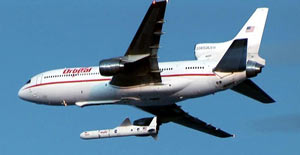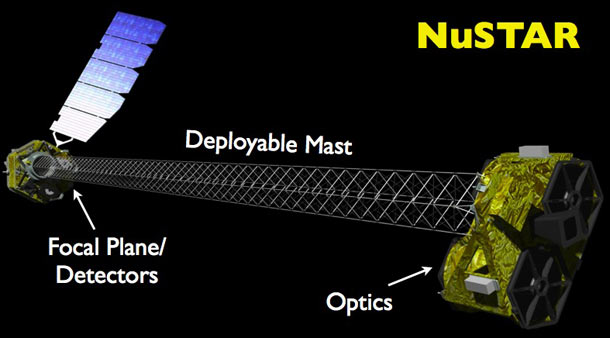Create a free profile to get unlimited access to exclusive videos, sweepstakes, and more!
NuSTAR launches into orbit!

 At 16:00 UTC June 13, 2012, the NuSTAR X-ray observatory began its successful journey into orbit! The satellite was launched using a Pegasus rocket, a smaller vehicle that is literally dropped from an airplane and blasts away into space. This method saves a huge amount of fuel by starting the rocket a few kilometers above the ground. [The image shown here is from a different Pegasus drop and is for explanatory purposes; I'm hoping to get some nice images of the actual NuSTAR launch soon.]
At 16:00 UTC June 13, 2012, the NuSTAR X-ray observatory began its successful journey into orbit! The satellite was launched using a Pegasus rocket, a smaller vehicle that is literally dropped from an airplane and blasts away into space. This method saves a huge amount of fuel by starting the rocket a few kilometers above the ground. [The image shown here is from a different Pegasus drop and is for explanatory purposes; I'm hoping to get some nice images of the actual NuSTAR launch soon.]
NuSTAR (NUclear Spectroscopic Telescope Array) is designed to detect high-energy X-rays emitted by some of the most violent objects in the Universe: exploding stars, matter falling into black holes, and magnetars (super-magnetic neutron stars that are capable of fierce blasts of energy).
X-ray astronomy is a lot harder to do than regular-old visible light astronomy. For one thing, our air absorb X-rays, so we have to launch telescopes into orbit to see these objects at all.
For another, at these high energies, it's not possible to focus X-rays in a normal way. Photons of visible light bounce off of mirrors, so we can focus them to a point and see distant objects clearly. X-rays are different, though. Think of them as little bullets zipping along; if they hit a mirror they'll penetrate right through it! So instead of using a reflective mirror, X-rays can be focused by letting them graze against a gently angled sheet of metal, like skipping a rock on the surface of a lake.
So X-ray observatories like Chandra, XMM-Newton, and NuSTAR use very long cylindrical mirrors. But not precisely cylinders; they gently taper at one end a bit like a thimble. X-rays graze these cylinders and bounce at a shallow angle, coming to a focus. The problem with this is that the angle is so shallow it takes a long path (called the focal length) to get the X-rays to a focus. So the telescopes have to be many meters long.
However, to fit on the diminutive Pegasus rocket, NuSTAR has to be only 2 meters long. Engineers solved this length problem in a very cool way: an extendable boom, like an accordion, that expands after launch and lengthens the spacecraft to over 10 meters! At one end of the extended mast are the mirrors, and at the other end are the detectors, as in the drawing above.
I'll note I worked on NuSTAR a few years back. When I was at Sonoma State University we developed educational activities based on NASA missions. We were asked to work on the original proposal for NuSTAR to NASA, so my boss Lynn Cominsky and I wrote the original Education and Public Outreach part of the proposal, and once it was accepted I wound up writing a lot of the verbiage for the NuSTAR educational website as well.
NuSTAR has a bit of a checkered history. I wrote about this a while back; in 2006 NuSTAR was abruptly canceled just before the final proposal was submitted to NASA (and I was, um, fairly angry about that), then reinstated a year or so later. But now NuSTAR is in orbit after a wonderfully perfect launch, and I'm very, very happy.
My congrats to the NuSTAR team, especially to Dr. Fiona Harrison -- to the best of my knowledge the first female Principal Investigator of a NASA astrophysics mission -- on finally getting this important mission into space and peering at some of the most interesting objects in the Universe!
Image credits: NASA/JPL-Caltech/Orbital; NASA/JPL-Caltech
Related Posts:
- Anniversary of a cosmic blast
- NuSTAR revived!
- An Open Letter to NASA



























